Venus Is Even More of a Hellscape Than We Imagined

Venus may be dotted with active volcanoes, new research claims.
Planetary scientists used old Venus mission data to create a series of computer simulations of Venetian volcanoes.
NASA is already pondering new missions to Venus; these findings could inspire Venus fever.
Venus is a strange, enchanting place. The rocky planet is often referred to as Earth's twin, because they're about the same size and have roughly the same mass. But there are some remarkable differences.
For starters, Venus is choked with a toxic atmosphere. Its surface can reach temperatures of up to 880 degrees Fahrenheit. And because it doesn't have plate tectonics like Earth does, scientists have long wondered whether the planet was geologically active at all.
But now, astronomers have spotted strange, ring-like features on Venus's surface—dubbed "coronae" after the the Latin word for crown—which indicates the planet could be more active than previously thought.
🌌 You love our insanely weird galaxy. So do we. Let's make this thing official.
“People have suggested that Venus is volcanically active before,” Anna Gülcher of the Swiss Federal Institute of Technology in Zurich, Switzerland, told New Scientist. “What we have done that is new is to map out these regions and correlate them to these specific sites.”
The scientists created a series of computer simulations that mapped out exactly how Venetian volcanoes would work, and what they might look like. They compared the data from these simulations to data collected during the European Space Agency's Venus Express mission and NASA's Magellan mission.
The imagery collected during these missions featured several sites that matched what the computer simulations showed. In total, the scientists identified 37 potentially active volcanic edifices in the Magellan data, collected between 1990 and 1994. Many were located around Venus's equator, which suggests the planet could have its very own "Ring of Fire" and a toasty, warm interior. The team's findings appear in the journal Nature Geoscience.
The researchers suspect these strange features form similarly to some of the volcanoes found here on Earth. Molten magma likely creeps up from planet's warm mantle, kind of like hotspot volcanoes that pop up in places like Hawaii and Yellowstone. And these things are massive; the average size of each corona is approximately 186 miles wide. That's more than twice the size of Hawaii's Mauna Loa, the largest volcano on Earth.
There's a lot the team still doesn't know—like how recently the volcanic coronae have been active. "It could be today or a couple million years ago," coauthor and geologist Laurent G.J. Montesi, of the University of Maryland at College Park, told CNN. The best way to answer these pressing questions and find out exactly what's happening on Venus's surface is to send a spacecraft there.
So it's a good thing that back in February, NASA announced it had selected four possible Discovery missions to explore the distant reaches of the solar system. Two of them, the DAVINCI+ (Deep Atmosphere Venus Investigation of Noble gases, Chemistry, and Imaging Plus) and VERITAS (Venus Emissivity, Radio Science, InSAR, Topography, and Spectroscopy), are designed to study Venus. If these missions are selected, they could help shed light on the planet's curious coronae.
You Might Also Like

